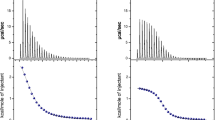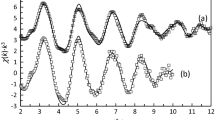Abstract
The rate of the reaction 2Fe(CN) 4−6 +S 2 O 2−8 → 2Fe(CN) 3−6 + 2SO 2−4 in the presence of Group IIA cations in aqueous solution has been studied over the range of ionic strength from 0.006 to 0.20 M at three temperatures between 5 and 35°C. The results are interpreted by means of the Brønsted(2) equation, and it is concluded that the actual reacting species are MFe(CN) 2−6 , and S2O 2−8 , where M is a Goup IIA metal. The contribution from the nonion-paired species seems to be negligibly small. Rate constants and activation parameters are reported for the observed reaction pathway, and these are compared with those for the same reaction carried out in the presence of alkali metal cations. The results are considered in terms of a mechanism involving cation bridging, and qualitatively this model is consistent with the trends in the results.
Similar content being viewed by others
References
R. W. Chlebek and M. W. Lister,Can. J. Chem. 44 437 (1966);45, 2411 (1967);49, 2943 (1971).
J. N. Brønsted,Z. Phys. Chem. (Leipzig) 102, 169 (1922);115, 337 (1925); S. W. Benson,The Foundations of Chemical Kinetics (McGraw-Hill Book Co., Inc., New York, 1960), p. 525.
G. Brauer,Handbook of Preparative Inorganic Chemistry, Vol. 2 (Academic Press, New York, 1965), p. 1509.
A. I. Vogel,Textbook of Quantitative Inorganic Analysis, 3rd ed. (Longmans, Green and Co., Ltd., London, 1962), p. 325.
J. Legros,J. Chim. Phys. 61, 909 (1964).
M. R. Kershaw and J. E. Prue,Trans. Faraday Soc. 63, 1198 (1967).
J. Holluta and W. Herman,Z. Phys. Chem. (Leipzig) A166, 453 (1933).
F. A. Jackman and M. W. Lister,J. Solution Chem. 4, 1023 (1975).
C. W. Davies,Ion Association (Butterworth and Co., Ltd., London, 1962), p. 170.
F. G. R. Gimblett and C. B. Monk,Trans. Faraday Soc. 50, 965 (1954).
D. A. MacInnes,J. Am. Chem. Soc. 41, 1086 (1919); R. M. Garrels,Glass Electrodes for Hydrogen and Other Cations, G. Eisenman, ed. (Marcel Dekker, Inc., New York, 1967), p. 344.
J. J. Kielland,J. Am. Chem. Soc. 59, 1675 (1937).
W. E. Dasent,Inorganic Energetics (Penguin Books, Harmsworth, 1970), p. 141.
K. J. Laidler,Can. J. Chem. 34, 1107 (1956).
Author information
Authors and Affiliations
Rights and permissions
About this article
Cite this article
Jackman, F.A., Lister, M.W. Ion pairing and the reaction of group IIA metal hexacyanoferrates(II) and peroxodisulfates. J Solution Chem 5, 417–430 (1976). https://doi.org/10.1007/BF00646416
Received:
Revised:
Issue Date:
DOI: https://doi.org/10.1007/BF00646416




